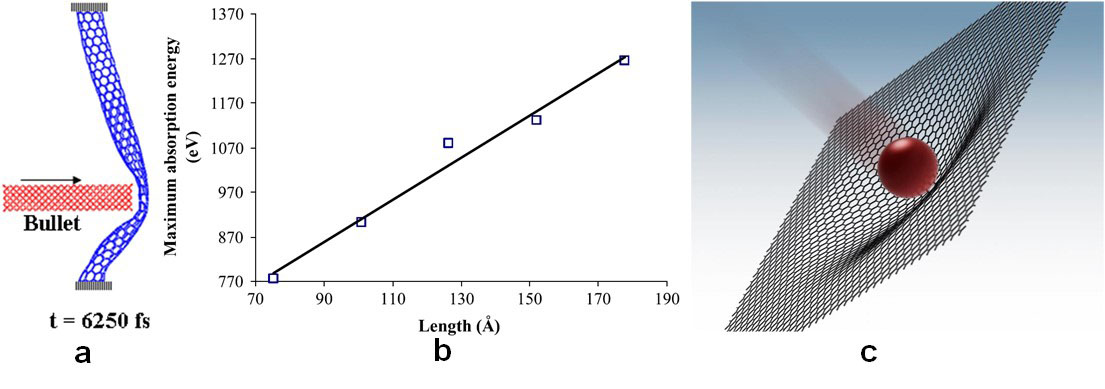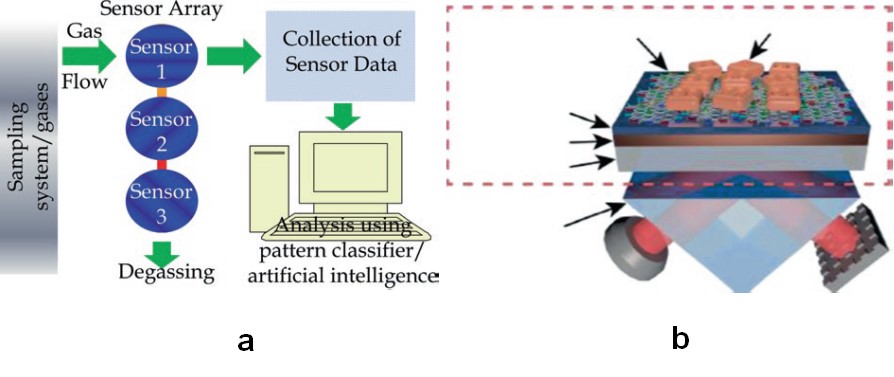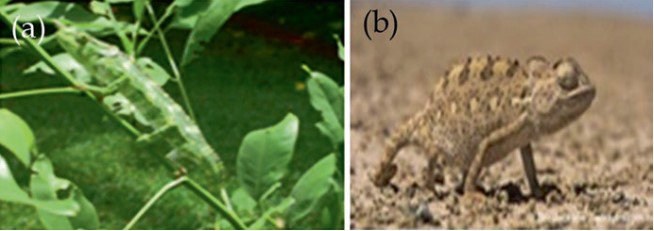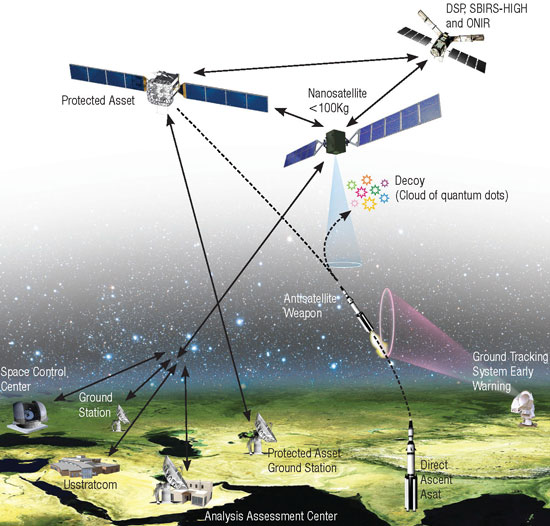| Aug 23, 2022 | |
How nanotechnologies are shaping the future of warfare |
|
| (Nanowerk Spotlight) Throughout human history, technological progress has been inseparably intertwined with advances in military weaponry. Through the ages we can see how new inventions revolutionized both the living standards of society and the advancement of warfare technology. The Stone Age, Bronze Age and Iron Age led to a progression of wooden, stone and metal weapons from arrows and bows to spears, axes, swords, chariots, and heavy siege weapons. | |
| With the invention of gunpowder in ninth-century China, chemical explosives entered the stage. While initially intended for use in pyrotechnics, it saw widespread use throughout the world in the development of small firearms and artillery guns. | |
| In the early 20th century, World War I became a flash point for the development of various advanced warfare technologies not only for ground wars (long and short range guns, tanks, chemical weapons) but also for emerging air forces (aircraft, helicopters) and navies (battle ships, submarines). The full-scale demonstration of these technologies appeared during World War II in addition to the development (and use) of the first nuclear weapons. | |
| The second half of the 20th century witnessed the moon race between the large superpowers USSR and USA, which led to the development of ever more powerful missiles. In addition, great emphasis was given to the development of ever more lethal weapons of mass destruction in the form of NBC (nuclear, biological, chemical) technologies despite a range of international treaties against the development and use of such weapons. | |
| This period also saw an increased emphasis on the development of protective technologies such as armour, camouflage, and stealth. | |
The rise of new technologies |
|
| The rapid emergence and confluence of nanotechnologies, biotechnologies and information technologies in the past two decades is having a huge impact on the development of military technologies. Some examples: | |
|
|
|
| Integrating various components of these technologies into an Internet of Military Things (IoMT) for combat operations, complete with artificial intelligence algorithms, advanced sensor technologies, and autonomous weaponry such as drones, will determine the shape and scope of futuristic battlefield scenario [1]. | |
| Future warfare technologies that will be greatly influenced by nanotechnologies include stealth, unmanned aerial vehicles (UAVs), precision-guided weapons, as well as miniaturized firearms, sensors, and energy harvesting technologies. Below we address several aspects that will be greatly impacted by future military technologies: | |
Smart Soldiers |
|
| Since prehistoric times, soldiers have been indispensable in fighting wars for any army – but their technology has changed immensely. | |
| For instance, the price of providing soldiers with modern communications and surveillance equipment comes with a heavy price – literally. It has been reported that the average weight of batteries carried by US Army combat personnel in Afghanistan could amount to 4.5kg – with some soldiers carrying 11-13kg depending on their battlefield role. Considering that a modern infantry soldier will carry equipment weighing 30-50kg, the need to reduce this burden has becomes a pressing issue for military R&D. | |
| In this context, very intensive efforts are being made by researchers to develop nanotechnology-driven textiles embedded with nanosensor elements for CBRN threats, insulated and water proof fabrics, together with light weight bullet and splinter protection. Furthermore, textiles embedded with photovoltaic, thermoelectric, or piezoelectric nanomaterials for energy harvesting and storage will reduce the dependence on conventional batteries. Integrating all these technologies will result in a dynamic, lightweight and comfortable-to-wear battle suit. | |
| Nanomaterial-enabled light-weight body armour | |
| Replacing the currently in use heavy-weight body armour (14-15 kg) is a strong R&D focus. Materials that meet the criterion for an armour should not only prevent the penetration of a bullet but should also have elastic energy for bouncing off or deflecting the bullet. Instead of the dense ceramics and steel that are currently used, various nanomaterials such as magnetic and nonmagnetic ceramics as well as carbon based systems have emerged as ultra light weight materials. | |
| Among them, carbon nanomaterials including carbon nanotubes (CNTs) and graphene are of great interest for the fabrication of ultra-light body armours because of their attributes: | |
|
|
|
 |
|
| Figure 1. a) Schematic representation of simulation studies of ballistic impact of bullet strike to nanotube at a relative height of 0.31 with both ends fixed. b) Variation of the maximum energy absorbed with nanotube length (Left and Middle adapted from ref.2); and c) schematic representation of mechanical strength of graphene, showing bulletproof capacity (adapted from ref.3). | |
| Nanomaterials for detection, protection, and decontamination of chemical and biological warfare agents (CBWAs) | |
| Nanomaterials, because of their atoms / molecules available on the surface as compared to those in the core (high surface to volume ratio), are of particular interest for detection, protection and decontamination of CBRN warfare agents. | |
| Nanomaterials in different geometrical shapes such as rods, wires, particles of metal oxides, carbon nanomaterials (CNT, graphene), transition metal chalcogenides and other 2D materials, self-assembled molecules and metal-organic framework (MOF) structures, etc, are under intensive investigation to develop sensors for different kinds of chemical and biological (warfare) agents. | |
| The major advantages of nanosensors for the detection of threats from chemical or biological warfare agents include their low cost and low power consumption without compromising their sensing response. Typical nanoenabled chemical and biosensors are shown in Fig. 2a,b below. | |
 |
|
| Figure 2. a) Schematic view of sensor array for detection of multiple agents simultaneously, that is, an analog for electronic nose [4] and b) SPR sensor chip based on graphene oxide???coated copper film with a dielectric layer interface [5]. | |
| Some of the nano metal oxides, for example, TiO2, CuxO (x=1,2), ZnO, γ-Al2O3, WO3, MoO3, MgO, and CaO, acting as heterogeneous catalyst, have shown potential to decompose and decontaminate surfaces contaminated by chemical warfare agents [6]. | |
| Nanoenabled energy harvesting and storage devices | |
| The battery load carried by soldiers could be reduced to a great extent by harvesting energy from renewable sources such as solar energy, waste heat and even the soldiers themselves from kinetic motion or body heat. Nano-enabled photovoltaic, thermoelectric, and piezoelectric devices, besides being very light in weight, are being developed in different configurations and could even be embedded in a soldier's uniform itself [6]. Some examples include: | |
| Ultrathin organic photovoltaic device: Recently, a group of Japanese researchers have demonstrated to fabricate an ultra thin flexible organic photovoltaic devices with efficiency ∼7.9% based on a new material called PNTz4T (Fig. 3a). The fabrics (Fig 3b) integrated with such photovoltaic devices are also washable [7]. | |
 |
|
| Figure 3. a) Schematic view of double-sided fabricated ultra-flexible organic photovoltaic (OPV) cells and b) washable and stretchable fabric embedded with OPVs [7]. | |
| Thermoelectric devices based on nanomaterials: A thermoelectric device is meant for converting heat energy into electrical energy, which is based on the Seebeck effect. Generally speaking, the efficiency of thermoelectric materials is low. However, the advancement in nanotechnology has led to the development of wearable thermoelectric devices, capable of converting human body heat into electricity of several µW. Nanomaterials, such as bismuth telluride, carbon nanotubes, and graphene, are of great significance for such applications, with better efficiencies. | |
| Batteries: Currently, lithium-ion batteries, having high energy density, long life and with rechargeable characteristics, are the preferred choice for powering portable electronic devices, including those used by the soldiers. The use of nanomaterials for electrodes may reduce the weight penalty without hampering battery performance. In this context, graphene has emerged as very attractive cathode material for making flexible thin films cathodes to replace conventional current collectors, such as aluminium and copper, without hampering the electron transfer efficiency. Further, graphene embedded with tin oxide nanoparticles as anode together with current collector (Fig. 4), exhibits very high anode capacity and electrochemical stability. | |
 |
|
| Figure 4. a) Tin oxide nanoparticle-embedded graphene nanoribbons as anode; (b) schematic representation of a rechargeable lightweight lithium-ion battery with its charge and discharge directions; and (c) nano LiCoO2 cathode [7]. | |
| Adaptive camouflage | |
| To mimic a chameleon's ability to repeatedly change its colour to blend into various backgrounds (Fig.5a,b),[8] has long been a challenge for military camouflage researchers. | |
 |
|
| Figure 5. Nature's adaptive camouflage displayed by a chameleon in (a) green and (b) desert backgrounds (adapted from ref.8). | |
| Adaptive camouflage is a very attraction proposition to deceive enemies??? target and signature acquisition and management. Various nanostructured materials are in the R&D stage, giving hope to achieve the goal of adaptive camouflage. | |
| In this regard, nanomaterials showing chromogenicity, i.e., a change in color on applying external stimuli such as light (photochromic), heat (thermochromic), electrical (electrochromic) or magnetic (magnetochromic) fields, are strong candidates to realize adaptive camouflage. | |
Nano Drones |
|
| Already, militaries and terrorist organisations alike have started making use of drones – which are hard to detect due to their small size – in their operations such as ground reconnaissance, surveillance, dropping of materials and weapons in hostile areas (Fig.6 a-c) [10]. | |
 |
|
| Figure 6. a) Artist's interpretation of insect-like killer robots; b) mosquito-like insect-sized nano bioweapons; and c) a tiny fly-like drone made of nanomaterials for spying and delivering chemical or biological agents [adapted from ref. 10]. | |
| Future nano drones along with their integration of miniaturized GPS, antennas, flight control systems, and satellite communication systems through Internet of Things (IoT) technologies will make them very strong candidates for surveillance operations. | |
| Further advancements in drone technology open the possibility of achieving insect-sized flying machines, which are capable of entering a building undetected (and return safely) to perform functions such as information gathering or weapons deployment. Such next-generation drones are likely to play a dominant role in urban warfare scenarios. | |
Nanotechnology-enabled passive satellite defence systems |
|
| The role of satellites has grown exponentially both in military and civil applications. Civil areas include remote sensing, telecommunications, direct television broadcasting, and global positioning systems (GPS). Military applications include more accurate information gathering and targeting. | |
| At the same time, threats towards satellites have risen significantly with possible attacks from long-range directed energy weapons such as lasers or high-powered microwaves as well as anti-satellite missiles. Safeguarding satellites could include passive countermeasures such as making it harder to target them or providing them with protection to withstand attacks. | |
| One way of protecting a satellite is to make use of decoys. The existing technology used by aircraft of using pyrolytic materials like Magnesium-Viton-Teflon (MVT) flares that produce intense radiation by means of an exothermic reaction is not an option due to a number of limitations such as the lack of oxygen in space, and the discrimination between target and the decoy from Long Wavelength Infrared sensors (LWIR) devices. | |
| In view of this, Raytheon Company has developed a counter measure system using quantum dots, illustrated in Fig. 7, to protect space assets such as satellites from missile attacks. The quantum dots of different sizes and shapes are consisted of nanoparticles of InSb, PbTe, HgTe, HgSe, CdTe, CdSe and CdS that are engineered to emit radiation having a radiation profile similar to that of the asset [11]. | |
 |
|
| Figure 7. Schematic of a countermeasure system: Anti-satellite weapon seeks the decoy cloud of quantum dots instead of the target satellite [11]. | |
| As far as protection from directed energy weapons (DEW) is concerned, there is a need to modify the surface of the satellite to deflect away the radiation of the DEWs. Coatings consisting of densely packed nanoparticles such as oxides of silicon, tungsten, etc., are believed to be a possible solution. | |
Nanotechnology for future naval vessels |
|
| Like in other warfare theatres, nanotechnology is going to play a critical role in naval warfare in terms of building naval vessels with high-strength and light-weight materials, hard to detect underwater and surface platforms (submarines, boats, ships, carriers), autonomous power generation equipment, and nanoenabled anticorrosion and antifouling coatings. Some prominent nanomaterials used in naval structural platforms, combat systems and on board functional equipment include: | |
|
|
|
Nanotechnology-enabled next-generation cyber security |
|
| Cyber security is an integral and essential part of protected communications and may be breached in a variety of ways through viruses, malware and hacking. Next-generation quantum algorithms and related hardware will also require a new architecture for entangled information sharing [13]. | |
| Nanotechnology-enabled hardware may lead to the development of quantum computing hardware and possible quantum cryptographic schemes. For instance, quantum dots of semiconducting materials may act as the source of entangled electrons, which can be used to transmit information with non-decodable quantum algorithms. | |
References |
|
| 1. Artificial Intelligence, The Role of AI in the Defence Sector | |
| 2. K. Mylvaganam, L.C. Zhang, Energy absorption capacity of carbon nanotubes under ballistic impact, Appl. Phys. Lett. 89, 123???127 (2006) | |
| 3. J.H. Lee, P.E. Loya, J. Lou, E.L. Thomas, Dynamic mechanical behavior of multilayer graphene via supersonic projectile penetration. Science 346, 1092???1096 (2014) | |
| 4. L.C. Wang, K.T. Tang, C.T. Kuo, C.L. Ho, S.R. Lin, Y. Sung, C. P. Chang, A portable electronic nose system with chemiresistor sensors to detect and distinguish chemical warfare agents. Proceedings of the 2009 IEEE 3rd International Conference on Nano/Molecular Medicine and Engineering, 18???21 Oct 2009. | |
| 5. Y.V. Stebunov, D.I. Yakubovsky, D.Y. Fedyanin, A.V. Arsenin, V.S. Volkov, Superior sensitivity of copper-based plasmonic biosensors. Langmuir 34(15), 4681???4687 (2018) | |
| 6. N. Kumar and A. Dixit, Nanotechnology for Defence Applications, 2019, Springer International. | |
| 7. H. Jinno, K. Fukuda, X. Xu, S. Park, Y. Suzuki, M. Koizumi, T. Yokota, I. Osaka, K. Takimiya, T. Someya, Stretchable and waterproof elastomer-coated organic photovoltaics for washable electronic textile applications. Nat. Energy 2, 780???785 (2017). | |
| 8. M. Stevens, S. Merilaita (eds.), Animal Camouflage: Mechanisms and Function (Cambridge University Press, 2011) | |
| 9. J. Ge, L. He, Y. Hu, Y. Yin, Magnetically induced colloidal assembly into field-responsive photonic structures. Nanoscale 3, 177???183 (2011) | |
| 10. A. Del Monte, Nano Weapons; a Growing Threat to Humanity 2017, PotomaBooks | |
| 11. A satellite defense system based on quantum dot technology. Nanowerk 2012 | |
| 12. N. Kumar, A. Dixit, A. Mathur, A. Kumar, Nanocomposites of mixed oxides of copper (CuxO: x=1, 2) in co-polymer matrix of aniline-formaldehyde, Process of its preparation and its end use application for Anti-corrosion/fouling/microbial coatings, Indian Patent (Filed). | |
| 13. M.A. Nielsen, I.L. Chuang, Quantum Computation and Quantum Information, 2010, Cambridge University Press. | |
| By N. Kumar (Ex Director, Defence laboratory, Jodhpur and CMD QNano advanced materials, Jodhpur ) and A. Dixit (Indian Institute of Technology, Jodhpur) For more information, interested readers may please contact nkjain.india8@ gmail.com or [email protected]. | |
|
Become a Spotlight guest author! Join our large and growing group of guest contributors. Have you just published a scientific paper or have other exciting developments to share with the nanotechnology community? Here is how to publish on nanowerk.com. |
|
